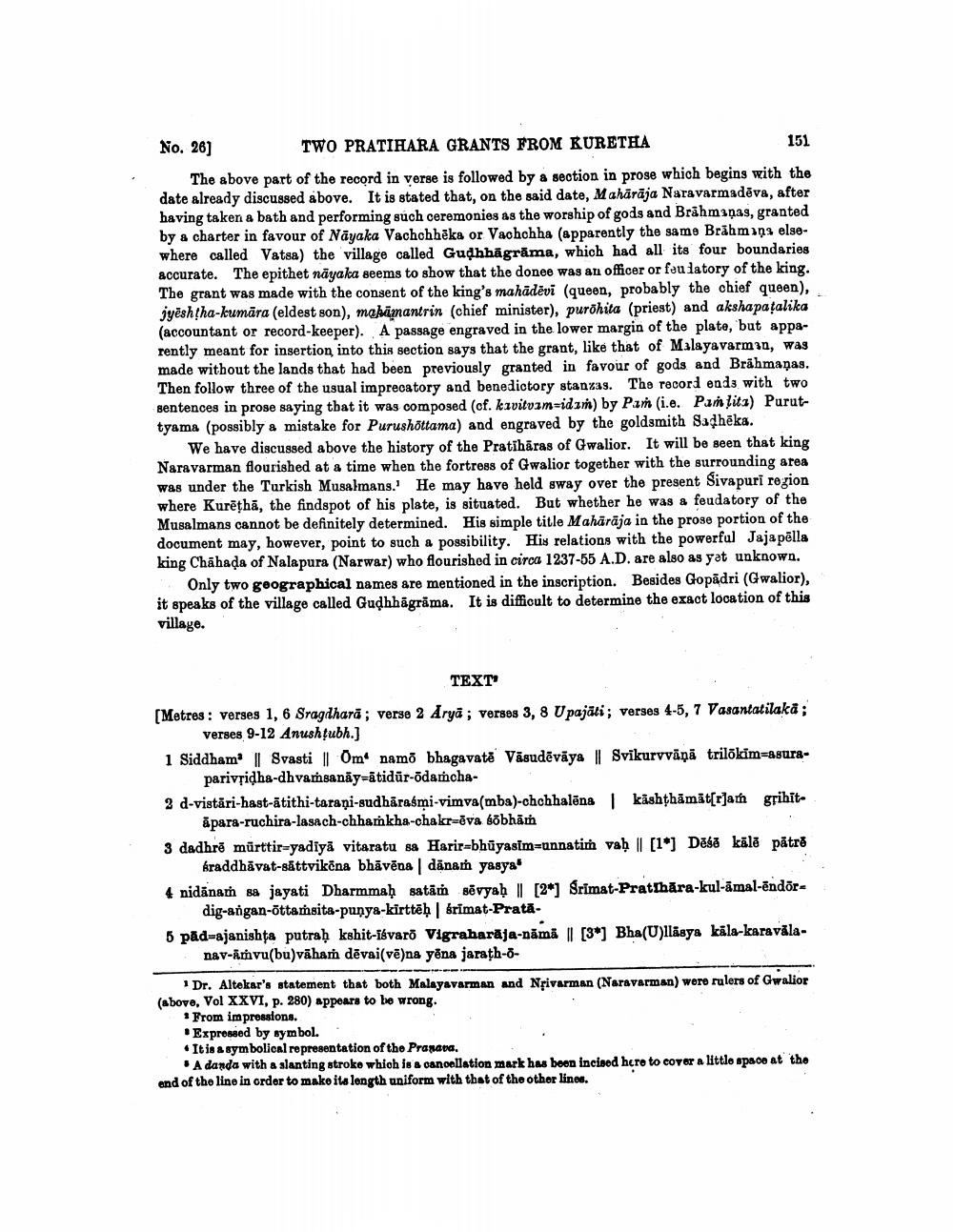________________
No. 26) TWO PRATIHARA GRANTS FROM KURETHA
151 The above part of the record in verse is followed by a section in prose which begins with the date already discussed above. It is stated that, on the said date, Mahārāja Naravarmadēva, after having taken a bath and performing such ceremonies as the worship of gods and Brāhmaṇas, granted by a charter in favour of Nayaka Vachchhēka or Vachchha (apparently the same Brāhmans elsewhere called Vatsa) the village called Gudhhāgrāma, which had all its four boundaries accurate. The epithet näyaka seems to show that the donee was an officer or foulatory of the king. The grant was made with the consent of the king's mahadevi (queen, probably the chief queen), jyështha-kumāra (eldest son), mahāgnantrin (chief minister), purðhita (priest) and akshapatalika (accountant or record-keeper). A passage engraved in the lower margin of the plate, but apparently meant for insertion into this section says that the grant, like that of Malayavarmun, was made without the lands that had been previously granted in favour of gods and Brāhmaṇas. Then follow three of the usual imprecatory and benedictory stanzas. The record ends with two sentences in prose saying that it was composed (cf. kavitvam-idan) by Par (i.e. Panțita) Puruttyama (possibly a mistake for Purushottama) and engraved by the goldsmith Sadhēka.
We have discussed above the history of the Pratihāras of Gwalior. It will be seen that king Naravarman flourished at a time when the fortress of Gwalior together with the surrounding area was under the Turkish Musalmans. He may have held sway over the present Sivapuri region where Kurētha, the findspot of his plate, is situated. But whether he was a feudatory of the Musalmans cannot be definitely determined. His simple title Mahārāja in the prose portion of the document may, however, point to such a possibility. His relations with the powerful Jaja pēlla king Chāhada of Nalapura (Narwar) who flourished in circa 1237-55 A.D. are also as yat unknown.
Only two geographical names are mentioned in the inscription. Besides Gopādri (Gwalior), it speaks of the village called Gudhhāgrāma. It is difficult to determine the exact location of this village.
TEXT
[Metres: verges 1, 6 Sragdharā; verse 2 Aryā; verses 3, 8 Upajati; verses 4-5, 7 Vasantatilaka ;
verses 9-12 Anushțubh.) 1 Siddham || Svasti || Om namo bhagavatė Väsudēvāya || Svikurvväņā trilõkim=asura
parivsidha-dhvamsanäy=ātidūr-odamcha2 d-vistāri-hast-ātithi-tarani-sudhārasmi-vimva(mba)-chchhalēna kashțhāmāt[r]am gribit
āpara-ruchira-lasach-chhamkha-chakr-ěva sõbhän 3 dadhrë mürttir=yadiya vitaratu sa Harir-bhūyasim=annatim vaḥ || [1] Dēsa kälē patro
kraddhăvat-sättvikēna bhāvēna | dänań yasya 4 nidāna sa jayati Dharmmaḥ satām sēvyah || [2*] Srimat-Prathāra-kul-āmal-ēndor
dig-angan-ottamsita-punya-kirttēh Srimat-Prata5 pād=ajanishţa putraḥ kshit-sávaro Vigraharaja-nămă || [3] Bha(U)lläsya kala-karavāla
nav-amvu(bu)vāham dēvai(vē)na yena jarath-8
Dr. Altekar's statement that both Malayavarman and Npivarman (Naravarman) were rulers of Gwalior (above, Vol XXVI, p. 280) appoars to be wrong.
From impressions. • Expressed by symbol. • It is a symbolical representation of the Prasara.
A danda with a slanting stroko which is a cancellation mark has been incised here to cover a little space at the end of the line in order to make ita length uniform with that of the other lines.




